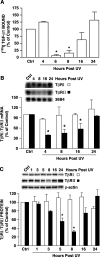Solar ultraviolet irradiation reduces collagen in photoaged human skin by blocking transforming growth factor-beta type II receptor/Smad signaling
- PMID: 15331399
- PMCID: PMC1618600
- DOI: 10.1016/s0002-9440(10)63337-8
Solar ultraviolet irradiation reduces collagen in photoaged human skin by blocking transforming growth factor-beta type II receptor/Smad signaling
Abstract
Ultraviolet (UV) irradiation from the sun reduces production of type I procollagen (COLI), the major structural protein in human skin. This reduction is a key feature of the pathophysiology of premature skin aging (photoaging). Photoaging is the most common form of skin damage and is associated with skin carcinoma. TGF-beta/Smad pathway is the major regulator of type I procollagen synthesis in human skin. We have previously reported that UV irradiation impairs transforming growth factor-beta (TGF-beta)/Smad signaling in mink lung epithelial cells. We have investigated the mechanism of UV irradiation impairment of the TGF-beta/Smad pathway and the impact of this impairment on type I procollagen production in human skin fibroblasts, the major collagen-producing cells in skin. We report here that UV irradiation impairs TGF-beta/Smad pathway in human skin by down-regulation of TGF-beta type II receptor (TbetaRII). This loss of TbetaRII occurs within 8 hours after UV irradiation and precedes down-regulation of type I procollagen expression in human skin in vivo. In human skin fibroblasts, UV-induced TbetaRII down-regulation is mediated by transcriptional repression and results in 90% reduction of specific, cell-surface binding of TGF-beta. This loss of TbetaRII prevents downstream activation of Smad2/3 by TGF-beta, thereby reducing expression of type I procollagen. Preventing loss of TbetaRII by overexpression protects against UV inhibition of type I procollagen gene expression in human skin fibroblasts. UV-induced down-regulation of TbetaRII, with attendant reduction of type I procollagen production, is a critical molecular mechanism in the pathophysiology of photoaging.
Figures







Similar articles
-
Fermentable metabolite of Zymomonas mobilis controls collagen reduction in photoaging skin by improving TGF-beta/Smad signaling suppression.Arch Dermatol Res. 2008 Apr;300 Suppl 1:S57-64. doi: 10.1007/s00403-007-0805-2. Arch Dermatol Res. 2008. PMID: 18060420
-
Protective effect of gelatin polypeptides from Pacific cod (Gadus macrocephalus) against UV irradiation-induced damages by inhibiting inflammation and improving transforming growth factor-β/Smad signaling pathway.J Photochem Photobiol B. 2016 Sep;162:633-640. doi: 10.1016/j.jphotobiol.2016.07.038. Epub 2016 Jul 26. J Photochem Photobiol B. 2016. PMID: 27491029
-
Ultraviolet irradiation represses TGF-β type II receptor transcription through a 38-bp sequence in the proximal promoter in human skin fibroblasts.Exp Dermatol. 2014 Oct;23 Suppl 1(0 1):2-6. doi: 10.1111/exd.12389. Exp Dermatol. 2014. PMID: 25234828 Free PMC article.
-
Blocking fibrotic signaling in fibroblasts from patients with carpal tunnel syndrome.J Cell Physiol. 2018 Mar;233(3):2067-2074. doi: 10.1002/jcp.25901. Epub 2017 May 3. J Cell Physiol. 2018. PMID: 28294324 Free PMC article. Review.
-
From receptor to nucleus: the Smad pathway.Curr Opin Genet Dev. 1997 Aug;7(4):467-73. doi: 10.1016/s0959-437x(97)80072-x. Curr Opin Genet Dev. 1997. PMID: 9309176 Review.
Cited by
-
Biological mechanisms underlying the ultraviolet radiation-induced formation of skin wrinkling and sagging II: over-expression of neprilysin plays an essential role.Int J Mol Sci. 2015 Apr 8;16(4):7776-95. doi: 10.3390/ijms16047776. Int J Mol Sci. 2015. PMID: 25856676 Free PMC article. Review.
-
Platelet-Rich Fibrin Lysate Can Ameliorate Dysfunction of Chronically UVA-Irradiated Human Dermal Fibroblasts.Yonsei Med J. 2016 Sep;57(5):1282-5. doi: 10.3349/ymj.2016.57.5.1282. Yonsei Med J. 2016. PMID: 27401663 Free PMC article.
-
Regenerative and reparative effects of human chorion-derived stem cell conditioned medium on photo-aged epidermal cells.Cell Cycle. 2016;15(8):1144-55. doi: 10.1080/15384101.2016.1158376. Cell Cycle. 2016. PMID: 27097375 Free PMC article.
-
Molecular Mechanisms of Changes in Homeostasis of the Dermal Extracellular Matrix: Both Involutional and Mediated by Ultraviolet Radiation.Int J Mol Sci. 2022 Jun 15;23(12):6655. doi: 10.3390/ijms23126655. Int J Mol Sci. 2022. PMID: 35743097 Free PMC article. Review.
-
The biological effect of recombinant humanized collagen on damaged skin induced by UV-photoaging: An in vivo study.Bioact Mater. 2021 Oct 22;11:154-165. doi: 10.1016/j.bioactmat.2021.10.004. eCollection 2022 May. Bioact Mater. 2021. PMID: 34938920 Free PMC article.
References
-
- Gilchrest BA, Yaar M. Ageing and photoageing of the skin: observations and the cellular and molecular level. Br J Dermatol. 1992;127:25–30. - PubMed
-
- Kaminer MS. Photodamage: magnitude of the problem. Gilchrest BA, editor. Cambridge: Blackwell Science,; Photodamage. 1995:pp 1–11.
-
- Warren R, Gartstein V, Kligman A, Montagna W, Allendorf R, Ridder G. Age, sunlight, and facial skin: a histologic and quantitative study. J Am Acad Dermatol. 1991;25:751–760. - PubMed
-
- Fisher GJ, Wang ZQ, Datta SC, Varani J, Kang S, Voorhees JJ. Pathophysiology of premature skin aging induced by ultraviolet light. N Engl J Med. 1997;337:1419–1428. - PubMed
Publication types
MeSH terms
Substances
Grants and funding
LinkOut - more resources
Full Text Sources
Other Literature Sources
Medical
Miscellaneous

